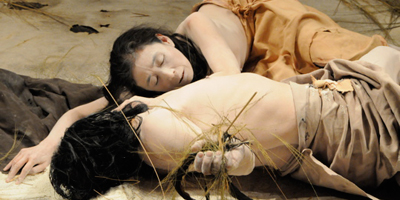
By Ivan Sygoda, Founding Director
A recent New York Times article (When the Art Isn’t on the Walls: Dance Finds a Home in Museums, by Hilarie M. Sheets; January 22, 2015) had me reflecting on longtime Pentacle artists Eiko & Koma’s extensive experience working in galleries and museums. The article touched on several valid points, but its focus on museum curators and on what they deem to be museum-worthy hot and trendy obscured some of the deeper and longer-standing reasons for artists to seek out what are often challenging opportunities. The physical and logistical parameters of most museum/gallery spaces are not dance-friendly; floors are not sprung, sightlines are poor, lighting is rarely flexible, dressing rooms are sometimes on a different floor, and access (and egress) can be difficult to control. So why are such invitations compelling? I think it is because contemporary museums and galleries provide a more welcoming context for choreographic explorations, and that context is an audience which is reliably curious about how artists think and work and evolve over time. Visual arts patrons seem more ready to be surprised or intrigued than fans who purchase concert tickets in advance.
It can be revealing to think cross-disciplinarily, even if the adverb has seven syllables. There are tourists who only attend their decade’s King Tut or Van Gogh blockbuster shows. These may be thought of as corresponding to the concert goers who only attend The Nutcracker (or step into a house of worship only at Christmas, Easter or Yom Kippur). Then there are the arts mavens who’ll eagerly visit the Met, the Louvre, the Prado, the Tate, etc., or more precisely whichever of these venerable institutions are not located where they live. These correspond to those essential devotees who check out NYCB, Taylor, and Ailey more or less annually. But what contemporary dance needs quite desperately are its “gallery goers,” patrons who are curious about what’s new, who take pleasure in following an intriguing artist’s evolution over time, who don’t need each new object to be a “masterpiece” of some sort and for whom the whole in which they take interest can be greater than the sum of the parts. They value process as well as product, an attitude that is more forgiving of those instructive failures which are integral to every artist’s progress. It’s a context that discards the old showbiz dictum that you are only as good as your last show. I cringe when I ponder the implications of this latter mindset for a dance-maker’s career.
Under the guidance of Sam Miller, the visionary arts activist quoted in the Times article, Eiko & Koma’s three-year Retrospective Project (2009-2012) successfully adapted museum audience engagement strategies to performance events housed in a variety of institutions. Their Retrospective has become a model for many artists and institutions. Almost any week’s dance listings feature exciting dance incursions into visual arts strongholds.
